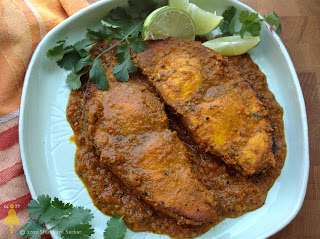I got the germ of this dish from Madhur Jaffrey’s Masala Fish Steak recipe, where she uses sweet red peppers as the base of the sauce. But I found her sauce too bland and better suited as a topping for grilled fish. So I amped-up the spice quotient with turmeric, coriander and black mustard, added fresh green chillies for heat, and cilantro and lime for freshness. I used swordfish here, but you can substitute with any firm-fleshed fish like salmon, trout, or cod.
3 tbsp Turmeric
Salt, to taste
1 large Red Pepper, seeded, de-veined, and roughly chopped
2 Shallots, roughly chopped
6–8 cloves Garlic, peeled
2-inch piece Ginger, peeled and roughly chopped
4–6 fresh Green Chillies
¼ cup Cilantro
Grated zest of ½ Lime
4 tbsp Vegetable Oil
1½ tsp Black Mustard Seeds
1 tbsp ground Coriander
¼ tsp Black Pepper
Juice of ½ Lime
Ingredients
2 lbs [1 kg] Swordfish steaks3 tbsp Turmeric
Salt, to taste
1 large Red Pepper, seeded, de-veined, and roughly chopped
2 Shallots, roughly chopped
6–8 cloves Garlic, peeled
2-inch piece Ginger, peeled and roughly chopped
4–6 fresh Green Chillies
¼ cup Cilantro
Grated zest of ½ Lime
4 tbsp Vegetable Oil
1½ tsp Black Mustard Seeds
1 tbsp ground Coriander
¼ tsp Black Pepper
Juice of ½ Lime
- Rub fish steaks with turmeric and salt and set aside for at least 30 mins, and up to 4 hours.
- Put red peppers and shallots in a food processor and pulse 4–5 times. Add garlic, ginger, green chillies, cilantro and lime zest, and grind until the mixture is a smooth paste. Pour mixture into a bowl and set aside.
- Heat 2 tbsp oil in a large skillet or frying pan over high heat. Add fish and brown well on both sides. Remove fish and set aside on a platter. Discard oil in pan and wipe clean.
- Heat remaining oil in same pan over high heat. When the oil is smoking, add black mustard seeds and let sputter for a few seconds until they start to pop. Add red pepper mixture, stir and fry for about 3 mins. Turn heat to low, add coriander, black pepper and salt and continue frying for 2 mins, until the sauce starts to dry out.
- Transfer browned fish to the pan, add limejuice, and spoon sauce over the fish. If the pan is too dry, add 2–3 tbsp water. Put a lid on the pan and let simmer for about 2–3 mins, until the fish is cooked-through. Serve garnished with cilantro and lime wedges.







